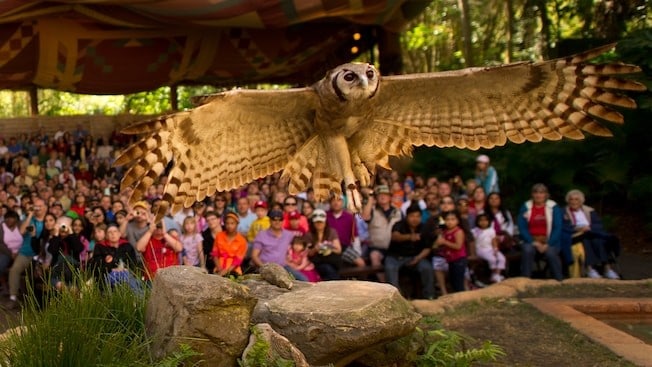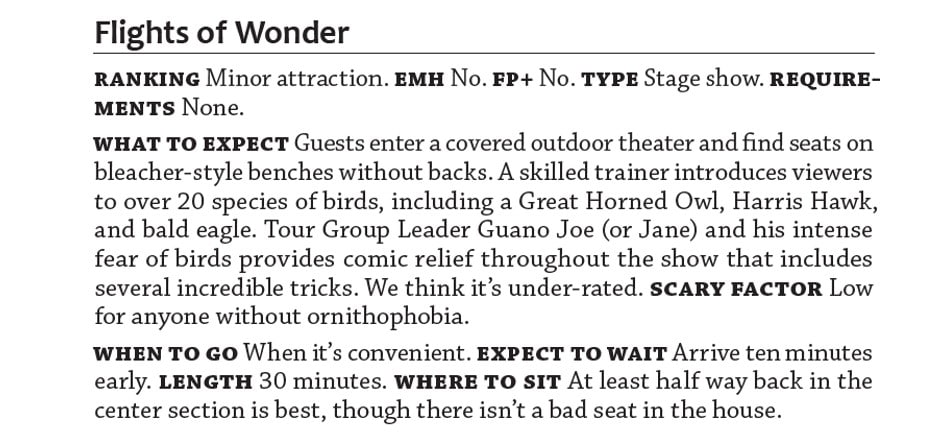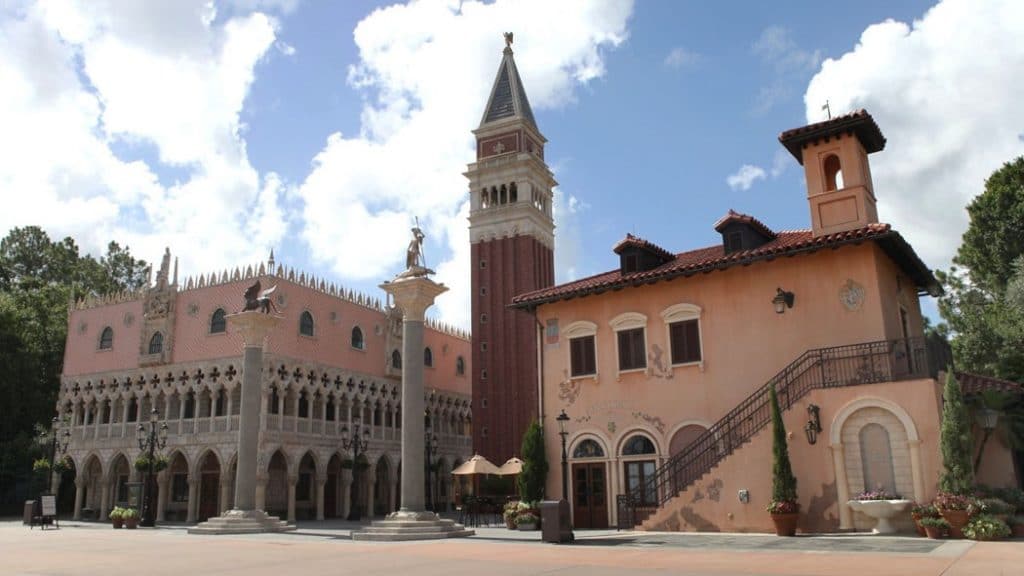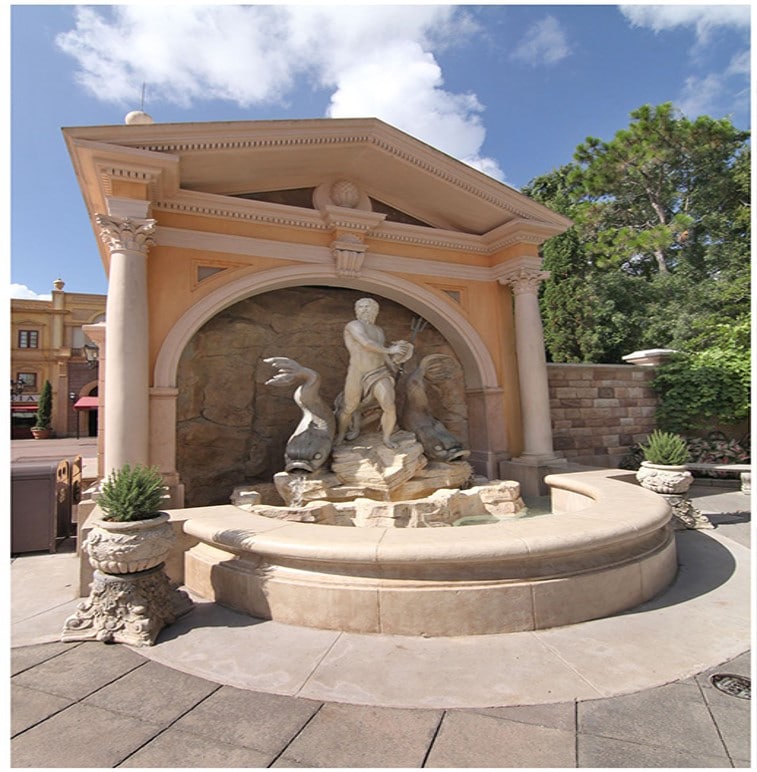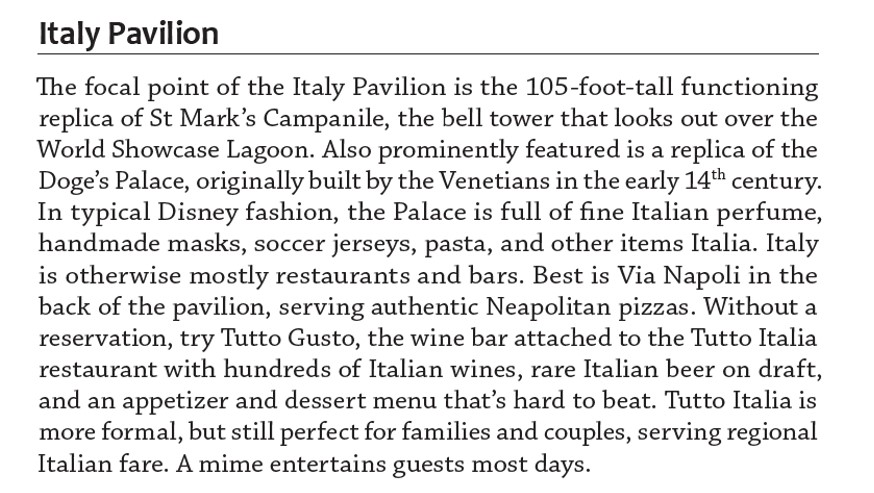Category — A Friday Visit with Jim Korkis
A Friday Visit with Jim Korkis: Totem Poles in Canada
Welcome back to Fridays with Jim Korkis! Jim, the dean of Disney historians, writes about Walt Disney World history every Friday on yourfirstvisit.net.
TOTEM POLES IN CANADA IN EPCOT’S WORLD SHOWCASE
By Jim Korkis
When Walt Disney World opened in 1971, the totem poles in Frontierland were meant to be artistic enhancements like on a movie set and not authentic re-creations. When Epcot opened a decade later, the same was true of the three fiberglass totem poles that decorated the entrance to the Canada pavilion.
Totem poles can recount tribal legends, commemorate people or significant events, represent supernatural powers, mark the territory of a specific tribe and more. Most guests were not troubled by these colorful fakes that added to the atmosphere of the area.
However, over the decades, the world’s attitude to respecting native cultures changed significantly. The Disney Company was sensitive to these changes and so for the Canada pavilion, even though it would not increase attendance or revenue, it was decided to change out the fiberglass totem poles to realistic cedar ones that would more accurately represent an authentic cultural experience.
In April 1998, Disney employed Tsimshian artist David Boxley from Alaska, noted for his decades-long dedication to authentic tribal art, to carve a 30-foot tall totem pole to replace the one near the trading post. Boxley was raised by his grandparents and taught the Tsimshian traditions.
This beautiful hand-carved totem pole tells the well-known tale from the Pacific Northwest Indians of Raven and Sky Chief. The Trickster Raven steals a “golden ball of light” from a hidden box and tosses it up into the sky where it becomes the sun, the moon and the stars.
In 1986, Boxley made a major decision to leave the security of a teaching position and devote all of his energies toward carving and researching the legacy of Northwest Coast Indian art. Boxley has carved over 68 totems in the last twenty-six years for institutions, museums, corporations and more.
He stated, “Carved from mature cedar trees, totem poles are an important part of the coastal First Nations culture. Totem poles were created and raised to represent a family-clan, its kinship system, its dignity, its accomplishments, it prestige, its adventures, its stories, its rights and prerogatives. A totem pole served, in essence, as the emblem of a family or clan and often as a reminder of its ancestry.”
On January 22, 2017 at 11:30 am, two new totem poles carved by Boxley were installed to replace the remaining original fiberglass poles at the Canada Pavilion.
The Eagle Totem Pole tells one of Boxley’s favorite cultural tales, in which a boy finds an eagle caught in a net on a beach and frees it. Years later, when hunger strikes the boy’s tribe, he walks on the same beach, only to find the eagle there waiting for him with food – paying him back for his kindness years ago. The bottom of this totem pole also tells the story of how a family of beaver taught a human family the importance of treating all creatures – human and animal – with respect.
The Whale Totem Pole depicts the tale of the first potlatch, a ceremonial feast celebrated by the Nagunaks and creatures of the undersea world.
The overnight installation was followed up with a dedication ceremony for the new poles that included a performance by the Git Hoan Dancers (People of the Salmon).
Based in Washington State, Git-Hoan members can trace their ancestral roots to some of the main tribes of Southeast Alaska, the Tsimshian, the Haida and Tlingit. They also performed at the Epcot International Festival of the Arts on January 21 & 22, 2017.
* * * * *
Thanks, Jim! And come back next Friday for more from Jim Korkis!
In the meantime, check out his books, including his latest, Secret Stories of Disneyland, and his Secret Stories of Walt Disney World: Things You Never You Never Knew, which reprints much material first written for this site, all published by Theme Park Press.
Follow yourfirstvisit.net on Facebook or Twitter or Pinterest!!
October 20, 2017 No Comments
A Friday Visit with Jim Korkis: Flights of Wonder
Welcome back to Fridays with Jim Korkis! Jim, the dean of Disney historians, writes about Walt Disney World history every Friday on yourfirstvisit.net.
FLIGHTS OF WONDER IN DISNEY’S ANIMAL KINGDOM
By Jim Korkis
When the Flights of Wonder show originally premiered at Disney’s Animal Kingdom in its opening year, it had a fanciful storyline and continued to evolve through several different versions.
It was finally re-scripted to be a more straight-forward educational presentation along with the comedy relief of a clueless tour guide character named “Guano Joe” who is more than a little fearful of these avian performers. Along with the audience, he learns about them and learns to love them. The roughly tweny-five minute show is performed several times a day.
Under the canvas canopy of a shady sanctuary that is what remains of the Maharajah’s crumbling fortress is the makeshift Caravan Stage in the “ruins” that are now the refuge for a dazzling array of birds. From opening until 2015, the Caravan Stage was covered with a canopy. A permanent roof was finally installed during a renovation in early 2016.
The façade of the roughly thousand person amphitheater is designed to resemble the architecture of that found in the Himalayan highlands or Rajasthan, India. The theater is situated outside the fictitious village of Anandapur, on the “trade route” towards Africa.
Guests are introduced to approximately twenty species of exotic birds who perform natural behaviors rather than the traditional silly tricks in some other bird shows. Some of the birds perform their antics onstage while others swoop over the audience and show off their dramatic wingspans.
While the show is entertaining and at times amusing, its core is a much deeper message about serious conservation themes and habitat loss. It promotes the World Wildlife Conservation Fund. The finale includes the appearance of an American Bald Eagle and the story of how thanks to concerted conservation efforts, this majestic bird is no longer endangered.
Among the species are birds most guests see include Barbary falcons, macaws, Amazon parrots, Harris Hawks, ibis, vultures, crowned cranes, a Trumpeter Hornbill, Great Horned Owl, Black Vulture, the previously mentioned American Bald Eagle and several other interesting birds. The birds are from various continents and not just Asia. While the specific birds may occasionally be different in each show, the format of the show remains the same.
The host is an actual trainer who has spent hours with these birds. The birds are trained to react and take different actions based on audio and visual cues they have been taught. Certain noises, words or a subtle hand placement will spark an action from the birds. While the show has been carefully rehearsed to demonstrate how birds hunt and eat, they have not been trained to do the typical tricks but merely duplicate natural behaviors with an emphasis on entertainment value like grabbing a dollar bill an audience member holds high in the air.
Groucho, the singing parrot in the show who is an audience favorite, was named the World’s Best Singing Parrot on the Tonight Show with Jay Leno after an appearance. He’s also appeared on other television shows including The Ellen DeGeneres Show.
He is fairly unusual for most parrots because he is able to sing seven full songs including How Much is that Doggy in the Window?, Camptown Races, Yankee Doodle Dandy, Alouetta and Jingle Bells.
Hatched in 1986 in Kalamazoo, Michigan and raised by Theresa Barylock, Groucho is a yellow naped Amazon parrot with an amazing ability to articulate many words and phrases such as “Look ma! No hands!”
In 2017, trainers and birds from the Flights of Wonder show now also made occasional appearances in Harambe and DinoLand U.S.A., again emphasizing the birds’ natural behaviors.
* * * * *
Thanks, Jim! And here’s more on FLights of Wonder from The easy Guide to Your Walt Disney World Visit 2018:
Come back next Friday for more from Jim Korkis!
In the meantime, check out his books, including his latest, Secret Stories of Disneyland, and his Secret Stories of Walt Disney World: Things You Never You Never Knew, which reprints much material first written for this site, all published by Theme Park Press.
Follow yourfirstvisit.net on Facebook or Twitter or Pinterest!!
October 13, 2017 No Comments
A Friday Visit with Jim Korkis: Italy in Epcot’s World Showcase
Welcome back to Fridays with Jim Korkis! Jim, the dean of Disney historians, writes about Walt Disney World history every Friday on yourfirstvisit.net.
REVISITING THE ITALY PAVILION
By Jim Korkis
Two massive columns can be found in the Piazzetta di San Marco in Venice, Italy. On top of the western column is a statue of Saint Theodore of Amasea slaying a dragon, and on top of the eastern column is a winged lion, a symbol closely associated with Saint Mark, the patron saint of the city. At different times, each of these saints were each considered the guardian of the city.
The winged lion has become the symbol of Venice and is also represented on the side of the Doge’s Palace. Public executions and legal gambling took place between the two columns. These famous columns have been duplicated in a smaller scale version for the entrance of the Italian pavilion in Epcot’s World Showcase.
Most towns across Italy were built around piazzas or town squares where people could mingle, interact and do their daily business. At this pavilion, there is the Piazza del Teatro (Theater Plaza) where a raised circular stage was built to showcase performances by groups like a street theater Commedia Dell Arte troupe known as the World Showcase Players and an instrumental group called Rondo Veneziano.
Surrounding the piazza is a wall. At the far end was the giardino, or garden, and behind the wall, Imagineers planted olive, cypress, pine and date palms on mounds to give the impression of an Italian provincial countryside that continued on forever and to hide the backstage perimeter road.
The planted trees were of varying ages to try to give the forest an authentic look. Originally there were plans for a gondola dark ride in this area that for budgetary and time restrictions was eliminated as the pavilion was being built.
To the right hand side of the wall is an ornamental gate, flanked by columns constructed from capitals of various designs. It is meant to look as if someone took the capitals from ancient ruins and piled one on top of the other to create this feature.
It was the intention of the Imagineers that this location was going to include replicas of Roman ruins. When budgetary issues resulted in that plan being abandoned, the designers adapted part of those features to build the gate. The columns look as if they’ve been constructed from the relics of other columns because they were originally designed to represent ruins.
The wall is overflowing with grape vines to represent Italy’s wine industry, one of the largest producers in the world.
Fountains can be found everywhere in Italy and many of them were designed by the nation’s most prominent artists. The Fontana di Nettuno (Neptune’s Fountain) in the pavilion is inspired by the sculpture work of Gian Lorenzo Bernini and such fountains as Rome’s Fontana del Nettuno, sculpted by Giovanni Ceccarini.
The fountain exemplifies the massive and elaborate style of many Italian fountains. It features the sea-god from Roman mythology accompanied by two dolphin companions who act as his messengers. The statue was framed with rebar and then sprayed with gunite (a mixture of cement, sand and water) to look like stone.
Those same dolphin designs can be found on other areas of Disney property from the door handles at the Doge’s Palace, to the ones at the Beach Club Resort that lead outside, to the enormous statues on top of the Dolphin Resort.
The water in this fountain is propelled through the dolphins’ mouths by a pump concealed within the structure behind it.
The coloring of the pavilion features delicate hues that are distinctive to Italy. A warm palette of shades of pink, reds, oranges, and yellow abound on the buildings and even the pottery.
* * * * *
Thanks, Jim! And here’s more on Italy from The easy Guide to Your Walt Disney World Visit 2018:
Come back next Friday for more from Jim Korkis!
In the meantime, check out his books, including his latest, Secret Stories of Disneyland, and his Secret Stories of Walt Disney World: Things You Never You Never Knew, which reprints much material first written for this site, all published by Theme Park Press.
Follow yourfirstvisit.net on Facebook or Twitter or Pinterest!!
October 6, 2017 No Comments
A Friday Visit with Jim Korkis: The Ganachery
Welcome back to Fridays with Jim Korkis! Jim, the dean of Disney historians, writes about Walt Disney World history every Friday on yourfirstvisit.net.
THE GANACHERY AT DISNEY SPRINGS
By Jim Korkis
The Ganachery Chocolate Shop opened in The Landing area of Disney Springs in December 2015. A framed sign on the brick wall in the shop with vintage lettering proclaims “Chocolate is Good Medicine”.
Hopefully, that sentiment is true, but it is placed in this location to explain the intricate design of the interior of this shop that now sells sweet treats. The building used to house the small town’s only apothecary shop that supplied the necessary medicines for the inhabitants to cure their ills.
Ganache is a mixture of chocolate and cream that is often used as an icing or glaze for pastries, but it can also be used as a filling for truffles or cakes. It is usually made with two-parts chocolate to one-part cream.
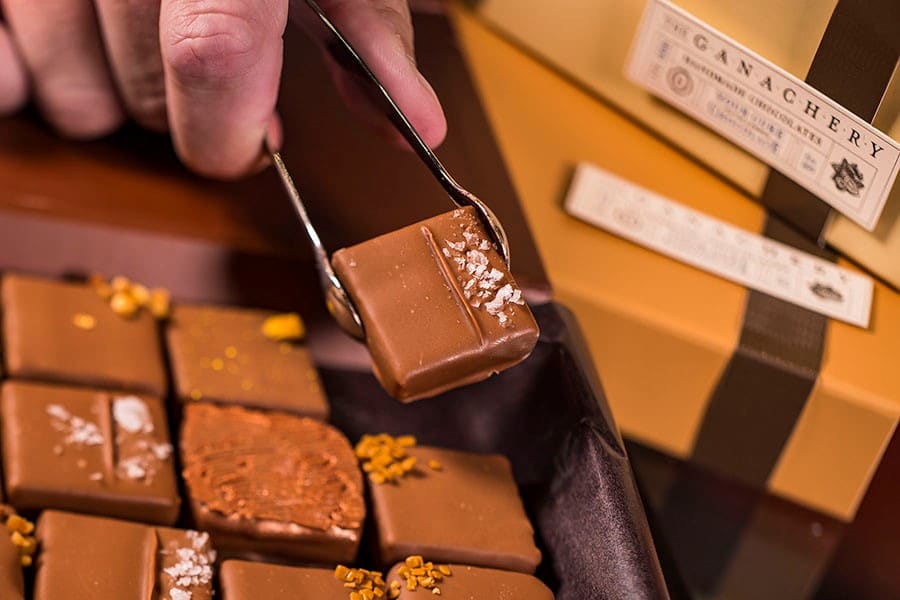
(C) Disney
Among other things, the shop offers sixteen different kinds of ganache squares, each made fresh in the store. A show kitchen workshop in the store allows guests to see the fascinating process up close before their very eyes.
“Walt Disney World chefs traveled the world to research and create a custom blend chocolate with the finest beans for the all-new concept that will feature freshly made ganache,” said a WDW press release. Cocoa beans for The Ganachery are sourced from Brazil, Peru, and the Dominican Republic.
WDW Imagineers created a fictitious history for Disney Springs and the buildings reflect the establishment and growth of the small town over the decades.
This particular building used to be the apothecary where residents of the Springs came for their medicinal needs. That explains the design of the vintage shelves and cubbyholes that were used to house various medicine bottles, boxes and vials but now hold chocolate instead. The ceiling is covered with beautiful stamped metal tiles appropriate for the original time period.
The space was taken over by a South American couple who turned their love for the cocoa bean from which chocolate is made into a fantastic chocolate shop. Most cocoa beans come from South America, so the Imagineers wanted to layer in hints of a Latin American atmosphere, from the ceramic drawer pulls to background music that includes a South American rhythm to reflect the heritage of the founding owners.
“We like to tell a story, because when guests arrive they want to feel like it’s a real place,” said Imagineer Theron Skees. “It’s a fresh take on an old apothecary. Bottles, scales and other props are inspired by drugstores of another era, and well-used copper pots add a layer of history. Be sure to check out the chandelier made from authentic copper pots and kettles used to make chocolate.”
Walls are painted the color of chocolate from dark brown to caramel. Photos on the wall are of the couple who opened the shop. The packaging design and all of the shop’s coloration are browns, caramel, cream and ivory, inspired by all the colors of chocolate. Basically, the combination of design, costumes, graphics, props and packaging combine seamlessly to tell the back story.
“The theming carries through right down to the packaging,” added Skees. “Traditional apothecary labels are ‘blocked’ with spaces for weights, measurements and descriptions, so we were inspired by that idea and made it more modern for the elegant chocolate bars and chocolate boxes.”
The clever tagline for the shop, “the cure for common chocolate”, references both the original apothecary shop and the current chocolate store.
“This is where Old World meets New World,” said Skees. “Our cast members will bring our story to life and make our guests feel part of it.”
* * * * *
Thanks, Jim! And come back next Friday for more from Jim Korkis!
In the meantime, check out his books, including his latest, Secret Stories of Disneyland, and his Secret Stories of Walt Disney World: Things You Never You Never Knew, which reprints much material first written for this site, all published by Theme Park Press.
Follow yourfirstvisit.net on Facebook or Twitter or Pinterest!!
September 29, 2017 No Comments
A Friday Visit with Jim Korkis: Cypress Point Lodge
Welcome back to Fridays with Jim Korkis! Jim, the dean of Disney historians, writes about Walt Disney World history every Friday on yourfirstvisit.net.
CYPRESS POINT LODGE
By Jim Korkis
The plan for Walt Disney World was for Disney themed resort hotels on property so that guests could stay for an extended vacation and have easy access to the theme park and surrounding amenities like golfing.
Originally, WDW featured the Polynesian Village Resort, the Contemporary Resort and Fort Wilderness Resort and Campground. The plan for Phase Two was to build within the next three years, three more resort hotels: The Asian, The Venetian and The Persian.
The Arab Oil Embargo of 1973 that dropped attendance at WDW by twenty percent or more prompted Card Walker, the conservative and cautious chairman of the board of the Disney Company, to delay proceeding with the building of those resorts even though land and infrastructure were already being prepared for The Asian.
The very small and inexpensively-themed Golf Resort (which later became Shades of Green) open in 1973. It was the last WDW owned resort hotel to open for fifteen years until the Grand Floridian Resort and Spa in 1988.
With the development of Epcot Center, the need for more hotel rooms on property to accommodate the hoped for influx of visitors became apparent and so plans were announced for more resorts.
Disney executive Dick Nunis was quoted in the May 1982 issue of the cast newspaper Eyes and Ears: “We also have in design three hotels. The Mediterranean will be located between TTC and the Contemporary. The Cypress Point Lodge will be west of River Country and be themed as a western hotel. It’ll include log cabins along Bay Lake.”
The third hotel would have been the Grand Floridian since preparation for the area had already been done years earlier. All three hotels were announced in 1980.
The November 4, 1982 issue of Walt Disney World Eyes & Ears provided the following description of the rustic, moderate resort:

“Neither the trees nor the buildings dominate the entire area; but blend together in a natural harmony. One can almost hear the crackling fireplace and feel the large wooden beams offer a haven of security and comfort.
“Cypress Point Lodge will also include: two restaurants, a pool, extensive beach, and lake dock. Guests will commute in and out of Cypress Point Lodge by watercraft.”
One of the advantages of building the hotel was it was not on the monorail loop and so would not disrupt its operation or the Magic Kingdom.
Obviously the location and theme echoed the Wilderness Lodge Resort that would be built in 1994 but with several key differences including several separate waterfront cabins.
The land in the area had been cleared of trees by 1971 although some claim that this was originally meant for additional campground. The 1973 WDW souvenir guide states that an unnamed “Lodge” was planned to be built at Fort Wilderness for guests. A rough replica of the resort was featured in the model in the post show area of Magic Kingdom’s The Walt Disney Story attraction.
However, cost overruns for the building of Epcot Center resulted in Cypress Point Lodge being cancelled and it is no longer mentioned in any documentation after 1983.
With the arrival of new CEO Michael Eisner in 1984, he chose to develop both the Grand Floridian and a lodge-themed resort but with much different approaches, which became the Wilderness Lodge.
* * * * *
Thanks, Jim! And the cabins in this area have now actually been built, although at a different price point than I imagine was contemplated then, in the Cascade Cabins at the Wilderness Lodge’s Copper Creek Villas and Cabins!
And come back next Friday for more from Jim Korkis!
In the meantime, check out his books, including his latest, Secret Stories of Disneyland, and his Secret Stories of Walt Disney World: Things You Never You Never Knew, which reprints much material first written for this site, all published by Theme Park Press.
Follow yourfirstvisit.net on Facebook or Twitter or Pinterest!!
September 22, 2017 No Comments
A Friday Visit with Jim Korkis: Turtle Talk with Crush
Welcome back to Fridays with Jim Korkis! Jim, the dean of Disney historians, writes about Walt Disney World history every Friday on yourfirstvisit.net.
TURTLE TALK WITH CRUSH AT EPCOT
By Jim Korkis
Turtle Talk with Crush is a popular theater show that is part of Disney’s Living Character Initiative program.
Bruce Vaughn, Vice President of Walt Disney Imagineering’s Research and Development Division said, “This is an incredibly compelling and powerful way to experience the characters. They are fully aware of the people in their presence and can call you by name. It is a 100 percent live experience.”
Crush is a laid-back green sea turtle over 150 years old who loves riding the ocean currents and talks with the stereotypical attitude and vocabulary of a California surfer. He first appeared in the Disney Pixar animated feature film Finding Nemo (2003) where he helped Dory and Marlin on their quest.
According to Crush himself, his father is named Mr. Turtle, so that would make Crush’s full name Crush Turtle, or C. Turtle (sea turtle) for short.
In the film, his voice is supplied by Nemo writer-director Andrew Stanton who recorded all of Crush’s dialog lying on his couch in his office.
The show is a mixture of technologies including computer graphic techniques, image projection, digital puppetry and improvisation. Some of the action is pre-created animated sequences that can be cued up when needed while some of the action is done in real time.
Crush is controlled onscreen in real time by a puppeteer who uses a telemetric input device similar to a keyboard so that it appears seamlessly in a virtual environment. The X-Y-Z axis movement of the input device causes the digital puppet to move correspondingly.
Basically, a talented performer behind the massive rear projection screen area that looks like a window in to the Pacific Ocean underwater environment speaks in an approximation of Crush’s familiar voice and it is transferred to the speakers in the small theater.
The avatar image is projected at 60 frames per second, so that the turtle’s mouth is perfectly sychronized with the performer’s words. The performance is a mixture of pre-scripted material and improvisational responses. Cameras mounted on either side of the screen, allows the performer to see the audience and to make specific references.
The same type of technology is used in the Monsters Laugh Floor attraction in Magic Kingdom.
Turtle Talk with Crush originally it opened on November 16, 2004 at The Living Seas pavilion at Epcot that was later renamed The Seas with Nemo and Friends. Another version opened at Disney California Adventure in July 2005. It was open briefly at Hong Kong Disneyland from May 24 to August 10, 2008. The attraction opened in Tokyo DisneySea on October 1, 2009.
A similar experience is also included in the Disney Cruise Line Animator’s Palate restaurants on the Disney Dream and Disney Fantasy ships. A Turtle Talk with Crush unit was donated by Walt Disney Imagineering to the Children’s Hospital of Orange County in early 2013 to entertain children and their siblings. It is operated twice a day by volunteering Disney cast members.
In May 2016 the theme park attraction added the characters of Dory, Destiny the whale shark, Bailey the beluga whale and Hank the “septopus” (a seven-legged octopus) along with Crush’s son Squirt.
It was reported that the addition of Turtle Talk with Crush to Disney TokyoSea cost a minimum of $13.1 million but does not include the “Dude speak” because the Imagineers felt that type of persona would not be completely understood by a Japanese audience. So, there Crush is just an overly friendly turtle.
* * * * *
Thanks, Jim! And come back next Friday for more from Jim Korkis!
In the meantime, check out his books, including his latest, Secret Stories of Disneyland, and his Secret Stories of Walt Disney World: Things You Never You Never Knew, which reprints much material first written for this site, all published by Theme Park Press.
Follow yourfirstvisit.net on Facebook or Twitter or Pinterest!!
September 15, 2017 No Comments




